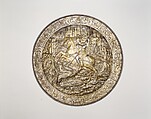Shield Depicting Saint George Slaying the Dragon
Italian armorers of the mid to late sixteenth century produced armors with amazingly lavish and complex decoration. They used a technique known as embossing or repoussé and chasing—the ornamentation of metal by raising designs in relief from the surface and then chiseling and filing the details on the front. Because this method seriously weakened armor plate and eliminated the smooth surfaces that served to deflect weapons, embossed armors were created exclusively for ceremonial use in military and civic festivals. Following the tradition of the Negroli armor workshop, Milanese armorers pursued new pictorial and sculptural styles of armor decoration. Shields, helmets, and entire armors were embossed with complex, multifigured scenes from ancient history, legends, mythology, and the Bible. To further enrich the raised surfaces, they were often damascened with gold or silver and contrasted with a russet or blued background. The finest armor decorator of the period was Lucio Piccinino (active about 1575–90), who reputedly designed, embossed, and damascened the armors himself, uniting skills usually assigned to separate craftsmen.
This image cannot be enlarged, viewed at full screen, or downloaded.

